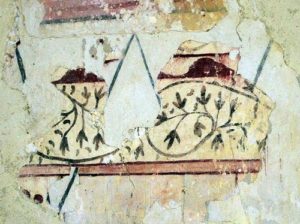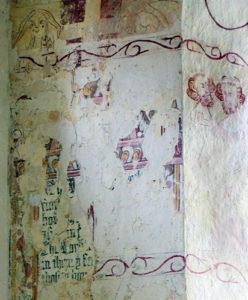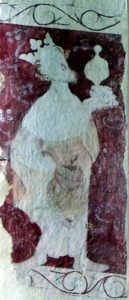This is in a lovely setting on top of the Warwickshire hills, on the edge of a Country Park with open grassland and trees.
This was once the centre of a wealthy wool area, but now the church is at the end of a road with just a farm and house for company.
There has been a church here since Saxon times. The present church dates from the 12thC when the nave and chancel were built. As the population grew, transepts and side aisles were added in the 14thC. A tower and porch followed in the 15thC when a clerestory was added.
The population plummeted during the Black Death and suffered further in Tudor times when the Lord of the Manor evicted twelve tenant farmers and enclosed 600 acres to sheep.
It is a lovely church built of deep honey coloured ironstone, and set in a graveyard with primroses, daffodils and lesser celandine. Bird song and the sound of bees were battling to drown out the sound of traffic on the nearby M40. Watch out for rabbit holes if walking round the graveyard.
It is a simple church with massive square tower at the west end with steps leading up to it. The long low nave and chancel still have Norman doorways. The church is built on a sloping site and the church slopes up to the chancel.
Entry is through the north porch with an ogee arch. Inside is the original Norman doorway with round arches and ball carvings.
It is a very attractive church inside with the plain glass clerestory windows flooding the church with light. Oil lamps still hang from the arches. Side aisles are separated from the nave by arcades pointed arches with small carved faces at the base and octagonal pillars with a narrow carved frieze at the top. There are intertwined flowers and stems as well as animal carvings. There is a dog chasing a hare, and winged monsters. Above are more carvings of animals and a green man holding foliage.
The floor standing wooden pulpit is also carved with flowers and grapes.
The chancel arch is supported by pillars with more carved capitals. Above is the remains of a 14thC wall painting with two censing angels with the Virgin Mary and St John. A flight of stairs leads up to the chancel which is empty apart from an old wooden table and altar rail.
At the end of the north aisle is a small chapel with more steps leading up to a stone altar set on the wall under the window. The aumbry in the north wall still has its door. There is a wall painting of one of the Magi on the side of the window. Round the arch is a pattern of small red flowers. To the left of the window is the remains of a post Reformation inscription.
On the east wall by the altar is a splendid stone memorial on the east wall surrounded by painted shields.
The south aisle has a small altar with the remains of a large stone tomb in front of it.
On the north wall of the nave are more post Reformation texts which have been painted over at least three times. The original 16/17thC text of the Lord’s Prayer is set in a yellow frame with blue and red fruit motifs. This has been overpainted with another Lord’s Prayer in a heart shaped frame with yellow strapwork decoration. In the 17thC the Creed was painted above these in a simple red, yellow and black border with floral motifs.
There are more traces of wall paintings on the south wall.
This is a lovely church in an idyllic situation and well worth finding.
The church is open daily and there is parking at the end of the road by the 19thC building over a Holy Well.










